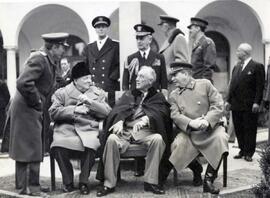ALANBROOKE, FM Alan Francis (1883-1963)
- ALANBROOKE
- Collection
- 1906-1968
Manuscript diaries, 1939-1946, notably covering his command of 2 Corps, BEF, France and Belgium, 1939-1940, his service as Commander-in-Chief, Home Forces, 1940-1941, and as Chief of the Imperial General Staff, 1941-1946, with detailed accounts of meetings and conversations, and comments on personalities. Detailed unpublished memoirs, 1883-1946, written in [1946-1960]. Personal files, 1940-1946, principally comprising copies of official and semi-official correspondence with FM Sir Bernard Law Montgomery, 1942-1945, relating to his commands of 8 Army, Middle East, 1942-1943, and 21 Army Group, North West Europe, 1944-1945; with FM Archibald Percival Wavell, 1st Viscount of Cyrenaica and of Winchester, 1940-1945, relating to his commands in the Middle East, 1940-1941, and India, 1941-1945; with FM Sir (Henry) Maitland Wilson, 1943-1945, relating to his commands in the Middle East, 1943-1944, and as head of British Joint Staff Mission, Washington, 1944-1945; with FM Hon Sir Harold Rupert Leofric George Alexander, 1942-1945, relating to his commands in the Middle East, 1942-1943, and Italy, 1943-1944, and the Mediterranean, 1944-1945; with Lt Gen Sir Kenneth Arthur Noel Anderson, 1942-1945, relating to his commands in North Africa, 1942-1944, and East Africa, 1945; with Adm Lord Louis (Francis Arthur Victor Nicholas) Mountbatten, Supreme Allied Commander, South East Asia, 1943-1945; with FM Sir John Greer Dill, head of British Joint Staff Mission, Washington, 1941-1944; with Lt Gen Frederick Arthur Montagu Browning, Chief of Staff, South East Asia Command, 1944-1945; with Lt Gen Herbert Lumsden, South West Pacific Area, 1944; with Lt Gen Sir Frank Noel Mason-Macfarlane, Governor and Commander-in-Chief, Gibraltar, 1942; and with Gen Wladyslaw Sikorski, Polish Forces, 1941-1943. Papers relating to his role as Chief of the Imperial General Staff, 1941-1946, dated 1940-1951, notably including conference papers for Combined Chiefs of Staff meetings, 1943-1945; semi-official correspondence with Lt Gen Sir Claude John Eyre Auchinleck, 1940-1945, relating to Auchinleck's commands in Norway, India and the Middle East, 1940-1945. Other papers relating to his life and career, 1897-1963, dated 1897-1966, 1992-1993, including letters to his mother, 1906-1920, notably covering his service in India, 1906-1914 and France and Belgium, 1914-1918; texts of his lectures on artillery given at Staff College, Camberley, 1923-[1926]; papers relating to his post-war activities, notably his role as Chancellor of Queen's University, Belfast, 1949-1963, dated 1949-1968; papers relating to ornithology, 1950-1963; published and unpublished articles collected by Alanbrooke and his wife, 1929-1967; texts of his speeches and broadcasts, 1944-1962; photographs, [1902-1963], 1978, 1992, mainly official photographs of Alanbrooke as Chief of Imperial General Staff, 1941-1942. Papers collected by Mrs M C Long in preparation for the writing of Alanbrooke's biography, dated 1954-1958, notably including texts of interviews with friends and colleagues, 1954-1958. Correspondence relating to Alanbrooke's papers and Sir Arthur Wynne Morgan Bryant's books Turn of the tide (Collins, London, 1957) and Triumph in the West (Collins, London, 1959) (both based on Alanbrooke's diaries), dated 1951-1968. Correspondence of FM (Richard) Michael (Power) Carver, Baron Carver, relating to erection of Alanbrooke statue in Whitehall in 1993, dated 1991-1993
Brooke, Alan Francis, 1883-1963, 1st Viscount Alanbrooke of Brookeborough, Field Marshal



